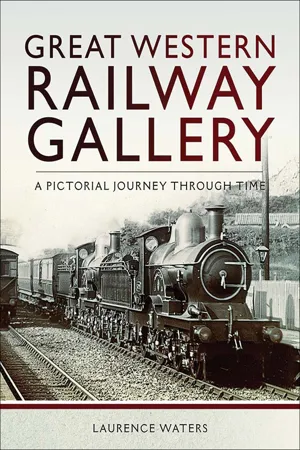
- 224 pages
- English
- ePUB (mobile friendly)
- Available on iOS & Android
About this book
It could be argued that the great Western or 'Gods' Wonderful Railway' was for many years the most famous railway in England. Much of the railway that we see today was the work of one of the greatest engineers of his time, Isambard Kingdom Brunel. The company was also served by locomotive engineers such as Gooch, Armstrong, Churchward, Collett and Hawksworth, who produced a series of locomotives that were well designed, elegant and powerful.Serving many holiday resorts of the south west, with trains such as 'The Cornish Riviera Express, ' the publicity department exploited to great effect that the 'Great Western' was the 'Holiday Line.' It is probably true to say that in the years before the Second World War the company was producing some of the most effective publicity material in England.Using previously unpublished material from the extensive 'Great Western Trust' collection at Didcot Railway Centre, the book illustrates in both black and white and color many facets that made the Great Western 'Great"
Frequently asked questions
- Essential is ideal for learners and professionals who enjoy exploring a wide range of subjects. Access the Essential Library with 800,000+ trusted titles and best-sellers across business, personal growth, and the humanities. Includes unlimited reading time and Standard Read Aloud voice.
- Complete: Perfect for advanced learners and researchers needing full, unrestricted access. Unlock 1.4M+ books across hundreds of subjects, including academic and specialized titles. The Complete Plan also includes advanced features like Premium Read Aloud and Research Assistant.
Please note we cannot support devices running on iOS 13 and Android 7 or earlier. Learn more about using the app.
Information
NINETEENTH AND TWENTIETH CENTURY STANDARD GAUGE LOCOMOTIVES










Table of contents
- Cover
- Title
- Copyright
- CONTENTS
- Foreword
- Acknowledgements
- Introduction
- Broad Gauge Locomotives
- Nineteenth and Twentieth Century Standard Gauge Locomotives
- Steam Railmotors
- GWR Petrol and Diesel Vehicles
- Oil Burning
- Engine Sheds
- Swindon Locomotive Works
- Signalling
- Accidents
- Publicity
- Named Trains
- Goods Services
- Staff
- Motor Bus Services
- Camp Coaches
- GWR Air Services
- Passenger Shipping Services
- Dining Great Western Style
- Bridges and Viaducts
- Paddington
- Country Stations
- Royal Trains